June 18, 2012
By Marc Bussanich, LaborPress City Reporter
Civil rights groups and New York’s unions silently marched from 110th Street to 79th Street along 5th Avenue, where Mayor Bloomberg owns a town house, to protest the NYPD’s “stop-and-frisk” tactics. According to the New York Civil Liberties Union, almost 700,000 people, mostly young black and Latino men, were stopped and frisked by the police in 2011.
NYCLU recently produced a report, “NYPD Stop-and-Frisk Activity in 2011,” revealing a detailed picture of the stop-and-frisk program. A snapshot of the report shows that there were 685,724 stops in 2011 (an increase of 14 percent from 2010) “spread unevenly amongst the city’s 76 precincts, with the 75th Precinct (East New York) leading the city with 31,100 stops.”
The report also states that while young black and Latino men between the ages of 14 and 24 account for only 4.7 percent of the city’s population, they accounted for 41.6 percent of stops in 2011.
 In addition, in 70 out of 76 precincts, black and Latino New Yorkers accounted for more than 50 percent of stops, and in 33 precincts they accounted for more than 90 percent of stops, according to the report, which is available on the NYCLU’s website:
In addition, in 70 out of 76 precincts, black and Latino New Yorkers accounted for more than 50 percent of stops, and in 33 precincts they accounted for more than 90 percent of stops, according to the report, which is available on the NYCLU’s website:
www.nyclu.org/files/publications/NYCLU_2011_Stop-and-Frisk_Report.pdf
While the march was silent for 21 blocks, marchers became very vocal at 79th and 5th Avenue. They expressed anger over NYPD’s tactics, as well as the recent shootings of Trayvon Martin in Florida and Ramarley Graham in New York. Ironically, the march occurred one day after the death of Rodney King, a victim of police brutality in Los Angeles in 1991 and whose case sparked urban unrest when four officers were acquitted of using excessive force.
Mayor Michael Bloomberg defends the tactic, but Ben Jealous, President and CEO of the NAACP, has said that other major cities in the U.S., including Los Angeles, Dallas and Baltimore have reduced violent crime without resorting to stop-and-frisk tactics.
 In an interview, he said, “In those cities, the cops say ‘we’re going to be officer friendly. We’re going to get to know the community and develop relations with the people in that community.’”
In an interview, he said, “In those cities, the cops say ‘we’re going to be officer friendly. We’re going to get to know the community and develop relations with the people in that community.’”
In contrast, “What’s going on in New York City is that the police are driving a wall because they’re frisking so many kids and so nobody wants to talk to the police.”
Jealous added, “I’ve talked to young women in their 20s who you could not mistake them for a threat to society on your worst day, but yet they’ve been frisked and humiliated. All they [NYPD] have to do is start treating our children with fairness and respect.”
Council Member Council Member Jumaane Williams said in an interview that “The problem inherit in a police officer’s job is the ability to stop someone if they need to. We don’t want to take that away.”
He added, “But they’re abusing this ability with a concrete policy based on racial profiling. If the Mayor and Police Commissioner are smart they would look to other cities to see how they reduced violent crime without racial profiling.”
Williams also noted that there are people at John Jay College who have been eager to meet with the city because the college does research showing the ineffectiveness of stop-and-frisk.
“The city has refused to meet. They seem more interested in a policy that makes headlines to lead people to believe that the city is doing things to make us safer,” said Williams.
The NYCLU also reports that, “The number of stops of young black men exceeded the entire city population of young black men (168,126 as compared to 158,406).
George Gresham, President of 1199SEIU, referenced that point in an interview.
“These communities where stop-and-frisk is happening are communities where our members live. Ramarley Graham’s mother is a 1199 member. If we don’t stop this, more and more of our members are going to be affected.”
Gresham didn’t know how many of his members have been subjected to stop-and-frisk, but noted that anytime there’s a meeting with, say, ten people in the room, inevitably there’s at least one person who says he or she has been frisked or knows someone who’s been.
“The ratio of 700,000 people being frisked in one year is more than the population of color itself in the city. So the odds of our members being frisked are pretty strong,” said Gresham.
Vincent Alvarez, President of the NYC Central Labor Council, said that what’s important to remember is that “This isn’t about individual police officers. We support them and the work they do. They’re working people just like us. They work hard.”
Rather, the march is about a specific policy that he and labor wants to see addressed. Comptroller John Liu has said that stop-and-frisk should be ended and one way to replace the tactic is to get the community, NYPD and other stakeholders involved.
“We have to debunk the myth that if we don’t support stop-and-frisk, that we’re against safe communities,” said Alvarez.
Hector J. Figueroa, SEIU 32BJ’s Secretary-Treasurer, said he and his members marched because they, and even members of the executive board, have been stopped and frisked.
He noted that the union has told the Mayor and city officials they want safe streets, but “We also want the opportunity for the NYPD to listen and work with us to find alternatives. It’s not right that a segment of the population is considered suspect just by the mere fact they’re walking the streets,” Figueroa said.
Arthur Cheliotes, President of CWA Local 1180, said his local silently marched because there’s a grave injustice being committed. The tactic is making some communities look like a police state.
“The message we’re sending today is that the tactic is no longer tolerable. Even the PBA has expressed concern about being pressured to meet quotas on the number of people they frisk. If they [city officials] want to deal with criminals they should go to Wall Street because that’s where the crimes are being committed,” Cheliotes noted.
Cheliotes suspects, given that the city’s real estate industry is a very powerful political force that has benefited from gentrification, one possible explanation for the high number of black and Latino young men being stopped is to make it difficult for them to feel safe to walk in their own communities so that they leave and new residents move in with the ability to pay for luxury residences. marc@laborpress.org

